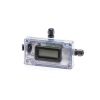Heron 4-20mA Pressure Transmitters
Features
- Accuracy of +/-0.1% full scale
- 4x overpressure rating
- Automatic barometric compensation through vented cable
- Free ground shipping
- Expedited repair and warranty service
- Lifetime technical support
- More
Overview
Heron Instruments 4-20mA pressure transmitter provides highly accurate water level measurement for a wide variety requirements that involve real time pressure readings. The Heron 4-20mA is ideal for use in tanks, wells and boreholes.
Easily Integrateable
The Heron 4-20mA is easily adapted to 3rd party data loggers, telemetry systems, Scada Systems, and digital displays.
Durable and Trusted
The two wire 4-20mA current loop is the most widely used signal transmission for transducers in industrial applications. It offers excellent noise immunity and is available in lengths up to 2000 ft (600m). Wide range of supply voltage (7.5VDC-35VDC) and reverse polarity protected.
*Requires vented cable and external power.
|
Performance |
|
|
# of Data Points |
N/A |
|
Download Speed |
N/A |
|
Accuracy %FS |
+/- 0.05%FS |
|
Stability %FS/year |
+/-0.20 |
|
Performance |
|
|
Pressure Ranges |
10m/30ft, 30m/100ft, 60m/200ft, 120m/400ft |
|
Overpressure Rating |
2X |
|
Operating Temperature |
-20˚C to 80˚C |
|
Pressure Resolution |
0.001 |
|
Supply Voltage |
7.5VDC - 35VDC |
|
Expected Battery Life |
N/A |
|
Warranty |
3 Years |
|
Physical Characteristics |
|
|
Wetted Material |
316 SS & Delrin |
|
O-Rings |
Rubber Buna |
|
Transducer |
316 SS Piezoresistive Silicon |
|
Weight |
170g (.37lbs) |
|
Length |
14.5cm (5.7") |
|
Diameter |
22mm (.9") |
|
Vented Direct Read Cable |
Polyurethane Jacketed |
In The News
Source Water Monitoring in Albany, New York: Tracing Water Quality throughout Tributaries
Thousands of US cities pull their drinking water from natural source waters like reservoirs, rivers, and streams, making overall watershed health a key consideration for water providers. In Albany, New York, the Albany Department of Water and Water Supply delivers drinking water to over 100,000 residents as well as monitors and manages the larger drinking water supply watershed. Hannah Doherty, Environmental Specialist at the Albany Department of Water and Water Supply , spends her days working with a small team to monitor the drinking supply and the connected water bodies. Doherty explains, “We’re the first to encounter the water that ends up being the drinking water.
Read MoreWildfire Prevention in the Sierra Nevada Region with the Yuba Watershed Institute
Though recent wildfires have sparked new conversations about wildfire management and response, groups like the Yuba Watershed Institute have been monitoring the forests and water resources of the Sierra Nevada region for decades, managing approximately 5,000 acres of land with the Bureau of Land Management (BLM) and about 7,000 acres in private land partnerships. The goal of the Institute is to work with local communities and land agencies to improve watershed and forestry management through informed practices and public outreach. The goals of the Yuba Watershed Institute are three-fold: Improve the ability of fire suppression agencies like the California Department of Forestry and Fire Protection ( CAL FIRE ) and the US Forest Service.
Read MoreWave Sensors Integration with NexSens Buoys: A Cutting-Edge Solution for Wave Measurment
Real-time wave data supports accurate weather prediction, safe and efficient maritime operations, and provides valuable safety and operating condition information for recreation and commercial fishing. Understanding wave dynamics also helps with the design of protective coastal structures like seawalls, breakwaters, and jetties. It also supports better prediction of their impact on sediment transport and coastal geomorphology. Wave data is a key factor in qualifying and designing offshore wind farms and harnessing kinetic energy for electrical generation. It helps with the understanding of ocean-atmosphere interactions and contributes to studies of sea-level rise and climate change impacts.
Read More













